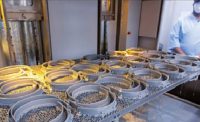Engineering schools around the United States have recently developed a variety of ingenious ways to address the coronavirus pandemic. Two of the most noteworthy ideas were the brainchild of engineers at the University of Illinois and the Massachusetts Institute of Technology (MIT).
The Illinois RapidVent emergency ventilator was developed in less than a week by a team at the Grainger College of Engineering. The device is designed to plug into the oxygen source available in most hospital rooms or it could plug into a tank of oxygen.
A prototype was created using high-end additive manufacturing equipment and then tested at the University of Illinois and Creative Thermal Solutions, a local company. The engineers evaluated existing products and collaborated with medical professionals to refine their design and make improvements.
“We have a team of brilliant, dedicated people that made something that actually works in less than one week,” says William King, a professor of mechanical science and engineering who headed up the project. “It’s very inspiring. Our team is living the Apollo 13 movie.
“The device delivers the amount of oxygen necessary and the pressure that patients would need when they are unable to breathe well enough on their own,” claims King. “So far, focused testing in the laboratory shows equivalent performance to commercial products, which are in very short supply.”
“We saw this massive, urgent need, and our partners from across the state jumped on it,” adds Rashid Bashir, dean of the Grainger College of Engineering and a professor of bioengineering. “This is precisely what America’s research universities and their partners are uniquely equipped to do.”
The prototype Illinois RapidVent ran for more than 75 hours, which is more than 125,000 breathing cycles. The next step in the development process is to identify partners and resources to mass-produce the device. The first company to step up is Belkin International Inc., a division of Foxconn that specializes in smartphone charging devices.
Disposable face shields are another medical device that has been in short supply due to COVID-19. To address the issue, engineers at MIT recently designed a device than can be rapidly mass-produced to meet unprecedented demand. It features a flat design that people can quickly fold into a three-dimensional structure when the shield is ready for use. Extra protection is provided by flaps that fold under the neck and over the forehead.
“These face shields have to be made rapidly and at low cost, because they need to be disposable,” says Martin Culpepper, a professor of mechanical engineering and director of Project Manus, MIT’s on-campus maker space and innovation thinktank. “Our technique combines low-cost materials with a high-rate manufacturing process that has the potential of meeting the need for face shields nationwide.
“When you’re thinking of materials, you have to keep supply chains in mind,” notes Culpepper. “You can’t choose a material that could evaporate from the supply chain. That is a challenging problem in this crisis.”
After testing a few materials that cracked and broke when bent, the Culpepper and his colleagues chose polycarbonate and polyethylene terephthalate glycol as the shield’s material.
Prototypes of the face shield were distributed to nurses and doctors at Boston area hospitals for testing. Participants were asked to provide feedback using a one-page survey.
“The feedback was overwhelmingly positive,” claims Culpepper. “Participants found that in addition to being easy to assemble and use, [our] shields provided good protection against coming in contact with virus particles through splashes or aerosolized particles.”
Armed with this feedback, the MIT engineers made a few minor adjustments to the design to maximize coverage around the sides and neck of users. With the design finalized, the project has now shifted to high-volume production.




